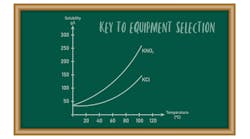I’ve never seen a piece of equipment that didn’t do what it was supposed to do. That doesn’t mean it did what its user thought it could do. In solids processing we often struggle with a piece of equipment because it was a poor selection or installed improperly or because we don’t want to spend the money for modifications so it can do the job right. The most common example of this type of mistake is installing something that would work fine on another product but not on the one you want to make. Usually, insufficient physical property data are to blame.
A fluid bed is a wonderful device for drying solids — but it doesn’t like sticky substances thrown at it. You can modify the dryer to handle sticky materials. However, this involves adding another component, such as a disperser or flash-dryer, to the system. An even better approach is to evaluate the sticky point (see “Surmount Sticky Situations”) during drying tests and maybe select a different dryer, such as a ball mill.
Physical property data are difficult and sometimes costly to obtain when working with solids. Knowing what to get for a particular technology isn’t always obvious, as in the case of crystallizers (“Get a Solubility Curve”). There are many elusive physical properties of solids other than stickiness. Most of these have simple ways to determine the property, or at least get a feel for where that property may cause a processing problem. A good example is de-aeration. A particulate solid that de-aerates slowly is a great choice for a fluid bed or pneumatic conveyor but doesn’t work well on a belt conveyor. Mixing in some larger particles can be a disaster because those particles can drop to the bottom of a container or segregate from the mix.
We had an extruder that was fed three different sized particles — one was fine and de-aerated in about 20 minutes while the other two were much larger. At first, we thought about using a blender or maybe a hopper to feed the extruder. A couple of trials on a small-scale convinced us that the only solution was to have no blend or surge capacity because the larger particles segregated too rapidly. Our solution even saved on the cost of the added equipment. Sometimes simpler is better.
A plant in a foreign country had purchased a piece of used drying equipment that was performing poorly. In those days, before the Internet enabled remote troubleshooting, it was difficult to diagnose the problem without a visit. The installation seemed to have enough capacity and heat input. Upon arrival, I saw the problem. This screw-style dryer had a single feed for the heating fluid that was split between the heated screw and the jacket. The plant relied on a manually operated valve to adjust the ratio of heating fluid going to the jacket and the screw; most of the fluid went to the jacket. It turns out the drawings the plant sent me were from the previous owner; it had a controller on the jacket as well as for the screw. Sometimes simpler is not better.
You must consider your workforce when selecting a new piece of equipment or even modifying a device. The expression “We have our ways” comes up all too often at project planning meetings. What’s worse is hearing, “We know the problems of this device and how to respond. A new device would bring new problems.” This latter opinion has a lot of merit in solids processing as we never can identify all potential problems. We just need to consider them in the design. When promoting a new type of equipment, I lobby management to send the operators to a site already using the device. (Of course, I cherry-pick the location.)
A classic example was when I suggested a fluid bed to replace a rotary drum dryer. The workforce knew how to replace the broken hammers with minimal downtime and didn’t mind hauling an entire load of product made unusable because of overheating or agglomeration. I took them to a vendor to observe our material and, later, to a facility that had replaced a rotary dryer. They endorsed the fluid bed and made some new friends. Oh, by the way, they got the right equipment.


